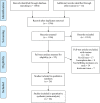A systematic review and meta-analysis for association of Helicobacter pylori colonization and celiac disease
- PMID: 33657108
- PMCID: PMC7928511
- DOI: 10.1371/journal.pone.0241156
A systematic review and meta-analysis for association of Helicobacter pylori colonization and celiac disease
Abstract
Background and objectives: Based on some previous observational studies, there is a theory that suggests a potential relationship between Helicobacter pylori (H. pylori) colonization and celiac disease (CeD); however, the type of this relationship is still controversial. Therefore, we aimed to conduct a systematic review and meta-analysis to explore all related primary studies to find any possible association between CeD and human H. pylori colonization.
Data sources: Studies were systematically searched and collected from four databases and different types of gray literature to cover all available evidence. After screening, the quality and risk of bias assessment of the selected articles were evaluated.
Synthesis methods: Meta-analysis calculated pooled odds ratio (OR) on the extracted data. Furthermore, heterogeneity, sensitivity, subgroups, and publication bias analyses were assessed.
Results: Twenty-six studies were included in this systematic review, with a total of 6001 cases and 135512 control people. The results of meta-analysis on 26 studies showed a significant and negative association between H. pylori colonization and CeD (pooled OR = 0.56; 95% CI = 0.45-0.70; P < 0.001), with no publication bias (P = 0.825). The L'Abbé plots also showed a trend of having more H. pylori colonization in the control group. Among subgroups, ORs were notably different only when the data were stratified by continents or risk of bias; however, subgroup analysis could not determine the source of heterogeneity.
Conclusions: According to the meta-analysis, this negative association might imply a mild protective role of H. pylori against celiac disease. Although this negative association is not strong, it is statistically significant and should be further considered. Further investigations in both molecular and clinic fields with proper methodology and more detailed information are needed to discover more evidence and underlying mechanisms to clear the interactive aspects of H. pylori colonization in CeD patients.
Systematic review registration number (prospero): CRD42020167730 https://www.crd.york.ac.uk/prospero/display_record.php?RecordID=167730.
Conflict of interest statement
The authors have declared that no competing interests exist.
Figures



Similar articles
-
Association Between Helicobacter pylori Colonization and Inflammatory Bowel Disease: A Systematic Review and Meta-Analysis.J Clin Gastroenterol. 2021 May-Jun 01;55(5):380-392. doi: 10.1097/MCG.0000000000001415. J Clin Gastroenterol. 2021. PMID: 32833699
-
Relationship between Helicobacter pylori infection and osteoporosis: a systematic review and meta-analysis.BMJ Open. 2019 Jun 27;9(6):e027356. doi: 10.1136/bmjopen-2018-027356. BMJ Open. 2019. PMID: 31248924 Free PMC article.
-
Artificial Intelligence for the Prediction of Helicobacter Pylori Infection in Endoscopic Images: Systematic Review and Meta-Analysis Of Diagnostic Test Accuracy.J Med Internet Res. 2020 Sep 16;22(9):e21983. doi: 10.2196/21983. J Med Internet Res. 2020. PMID: 32936088 Free PMC article.
-
Association of Helicobacter pylori infection with esophageal adenocarcinoma and squamous cell carcinoma: a meta-analysis.Dis Esophagus. 2014 Sep-Oct;27(7):645-53. doi: 10.1111/dote.12194. Epub 2014 Mar 17. Dis Esophagus. 2014. PMID: 24635571
-
Helicobacter pylori infection and the risk of colorectal carcinoma: a systematic review and meta-analysis.Minerva Med. 2019 Oct;110(5):464-470. doi: 10.23736/S0026-4806.19.05942-1. Minerva Med. 2019. PMID: 31368293
Cited by
-
Checkpoint Inhibitors and Induction of Celiac Disease-like Condition.Biomedicines. 2022 Mar 4;10(3):609. doi: 10.3390/biomedicines10030609. Biomedicines. 2022. PMID: 35327411 Free PMC article. Review.
-
Why are western diet and western lifestyle pro-inflammatory risk factors of celiac disease?Front Nutr. 2023 Jan 20;9:1054089. doi: 10.3389/fnut.2022.1054089. eCollection 2022. Front Nutr. 2023. PMID: 36742009 Free PMC article. Review.
-
From an understanding of etiopathogenesis to novel therapies-what is new in the treatment of celiac disease?Front Pharmacol. 2024 Apr 18;15:1378172. doi: 10.3389/fphar.2024.1378172. eCollection 2024. Front Pharmacol. 2024. PMID: 38698821 Free PMC article. Review.
-
Factors Affecting Prognosis in the Course of Pediatric Celiac Disease.Cureus. 2022 Dec 5;14(12):e32208. doi: 10.7759/cureus.32208. eCollection 2022 Dec. Cureus. 2022. PMID: 36620822 Free PMC article.
-
Helicobacter pylori Infection in Children Versus Adults, Differences in Management Guidelines: Risks and Benefits of Treatment in Childhood.Helicobacter. 2025 Jul-Aug;30(4):e70063. doi: 10.1111/hel.70063. Helicobacter. 2025. PMID: 40798867 Free PMC article. Review.
References
Publication types
MeSH terms
LinkOut - more resources
Full Text Sources
Other Literature Sources
Medical

